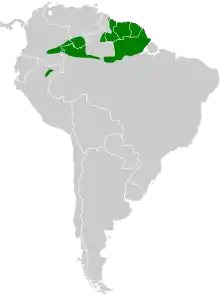| Black-headed antbird | |
|---|---|
%253B_Serra_do_Navio%252C_Amap%C3%A1%252C_Brazil_(cropped).jpg.webp) | |
| Scientific classification | |
| Domain: | Eukaryota |
| Kingdom: | Animalia |
| Phylum: | Chordata |
| Class: | Aves |
| Order: | Passeriformes |
| Family: | Thamnophilidae |
| Genus: | Percnostola |
| Species: | P. rufifrons |
| Binomial name | |
| Percnostola rufifrons (Gmelin, JF, 1789) | |
 | |
The black-headed antbird (Percnostola rufifrons) is a species of passerine bird in the antbird family Thamnophilidae. It is found in Brazil, Colombia, French Guiana, Guyana, Peru, Suriname, and Venezuela. Its natural habitat is subtropical or tropical moist lowland forests.
Taxonomy
The black-headed antbird was formally described in 1789 by the German naturalist Johann Friedrich Gmelin in his revised and expanded edition of Carl Linnaeus's Systema Naturae. He placed it with the thrushes in the genus Turdus and coined the binomial name Turdus rufifrons.[2] The specific epithet rufifrons combines the Latin rufus meaning "red" or "rufous" with frons meaning "forehead" or "front".[3] Gmelin based his description on "Le merle roux de Cayenne" that had been described and illustrated in 1775 by the French polymath, the Comte de Buffon in his book Histoire Naturelle des Oiseaux.[4][5] The black-headed antbird is now placed together with the Allpahuayo antbird in the genus Percnostola that was introduced in 1860 by Jean Cabanis and Ferdinand Heine.[6][7]
Four subspecies are recognised:[7]
- P. r. rufifrons (Gmelin, JF, 1789) – the Guianas and northeast Brazil
- P. r. subcristata Hellmayr, 1908 – north Brazil
- P. r. minor Pelzeln, 1868 – east Colombia, southwest Venezuela and northwest Brazil
- P. r. jensoni Capparella & Rosenberg, GH & Cardiff, 1997 – northeast Peru
References
- ↑ BirdLife International (2016). "Percnostola rufifrons". IUCN Red List of Threatened Species. 2016: e.T22701752A93847880. doi:10.2305/IUCN.UK.2016-3.RLTS.T22701752A93847880.en. Retrieved 12 November 2021.
- ↑ Gmelin, Johann Friedrich (1789). Systema naturae per regna tria naturae : secundum classes, ordines, genera, species, cum characteribus, differentiis, synonymis, locis (in Latin). Vol. 1, Part 2 (13th ed.). Lipsiae [Leipzig]: Georg. Emanuel. Beer. p. 825.
- ↑ Jobling, James A. (2010). The Helm Dictionary of Scientific Bird Names. London: Christopher Helm. pp. 341–342. ISBN 978-1-4081-2501-4.
- ↑ Buffon, Georges-Louis Leclerc de (1775). "Le merle roux de Cayenne". Histoire Naturelle des Oiseaux (in French). Vol. 3. Paris: De l'Imprimerie Royale. pp. 402–403.
- ↑ Buffon, Georges-Louis Leclerc de; Martinet, François-Nicolas; Daubenton, Edme-Louis; Daubenton, Louis-Jean-Marie (1765–1783). "Merle roux, de Cayenne". Planches Enluminées D'Histoire Naturelle. Vol. 7. Paris: De L'Imprimerie Royale. Plate 644.
- ↑ Cabanis, Jean; Heine, Ferdinand (1860). Museum Heineanum : Verzeichniss der ornithologischen Sammlung des Oberamtmann Ferdinand Heine, auf Gut St. Burchard vor Halberstadt (in German and Latin). Vol. 2. Halberstadt: R. Frantz. p. 10.
- 1 2 Gill, Frank; Donsker, David; Rasmussen, Pamela, eds. (January 2023). "Antbirds". IOC World Bird List Version 13.1. International Ornithologists' Union. Retrieved 15 March 2023.
